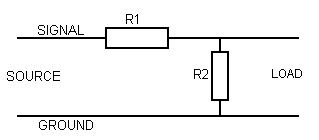DIY passive attenuation
From SqueezeboxWiki
Contents |
Building a Passive Attenuator
If you decide to connect your Squeezebox or Transporter analogue output directly to a power amp, it's possible (actually, fairly likely) that the level will be too high. So you need to add some passive attenuation. As explained in the ConnectToPowerAmp page, there are a number of commercially available options, but they are all pretty expensive. If you know how to use a soldering iron, you can add passive attenuation very easily for just a few pennies.
Passive attenuation is achieved using a simple voltage divider, which consists of just two resistors. I recommend you use low power (eg. 0.6W) 1% metal film resistors. Here is the basic circuit layout:
The goal is to select values for R1 and R2 which: (i) provide the necessary attenuation; and (ii) don't affect the source and load impedances too much. You need to know the output impedance of the source component and the input impedance of your power amp. Then plug in various values for R1 and R2 into the following formulae to calculate their effect:
Attenuation in dB = 20 * Log( R1 / ( 1 / ( 1/R2 + 1/LoadImp )) ) New Source Impedance = 1 / ( 1 / (SourceImp + R1) + 1/R2 ) New Load Impedance = R1 + 1 / ( 1/R2 + 1/LoadImp )
Here is an Excel spreadsheet that can help with these calculations. There is also a web calculator to calculate R1 and R2.
What you'll find is that the source impedance will be increased, while the load impedance will decrease. Ideally you want to minimise the extent of these changes. You may read elsewhere that the load impedance should be at least 10 times the source impedance, and while this is certainly desirable, in practice you can afford for the source impedance to get as high as about 2000 Ohms, and the load impedance to get down as low as 5000 Ohms, provided you are not using very long interconnects (say, more than 20 feet).
Let's take a simple example. The Squeezebox has an output impedance of 220 Ohms. Suppose you have a power amp with an input impedance of 20 kOhms. Using R1=5100 and R2=1300, we get an attenuation of 12.4 dB, a new source impedance of 1044 Ohms and new load impedance of 6320 Ohms. (The Transporter's output impedance is 100 Ohms rather than 220. But this makes no practical difference - in the example above using the same resistors, the only change is that the new output impedance is 1040 rather than 1044 Ohms; the other figures stay virtually the same).
Once you've decided on the values for R1 and R2, all that remains is to insert them into the plugs at the power amp end of the interconnect leads. Typical interconnects use RCA (phono) plugs. R1 goes into the signal (centre) lead, and R2 goes between the signal pin and ground. You may find that the plugs you already have are too small to fit a pair of resistors. In that case, you'll need to buy some larger bodied plugs to replace them. (Where I live, in the UK, Maplin sell some quite large bodied phono plugs: order codes JU06/JU07/JU08/JU09. I'm sure similar items can be bought at places like Radio Shack).
Balanced Power Amps
What if your power amp has balanced inputs? There are two possibilities here, depending on whether the source component has balanced or unbalanced outputs.
Unbalanced Source (Squeezebox)
Let's begin by considering an unbalanced source component. Here, the ground output from the Squeezebox will be connected to one side of the balanced power amp (typically the "cold" input, usually on pin 3 of an XLR connector) and the signal is connected to the other side (the "hot" input, usually on pin 2). It's perfectly OK to swap this round: ground to "hot" and signal to "cold", provided you remain consistent across both channels. Now, the ground output from the Squeezebox carries no signal at all, so it doesn't need to be attenuated. All you need to do is add two resistors, just like in a purely unbalanced setup. Add R1 in the line that receives the signal, and connect R2 between that and the other input line. For example, if the Squeezebox signal goes to pin 2 of the XLR, add R1 between it and pin 2, and add R2 between pins 2 and 3.
Note that there are some important grounding issues you need to consider when driving a balanced power amp from an unbalanced source. See the page BalancedPowerAmps.
Balanced Source (Transporter)
OK, what about a balanced source component? Here you'll need to attenuate both sides. This means you'll need four resistors in the XLR plug. Two instances of R1 in the two signal lines (pins 2 and 3), and two instances of R2: one between pin 2 and pin 1, and the other between pin 3 and pin 1. It is a bit of a tight squeeze to fit four resistors into an XLR plug, but it's perfectly doable.
Stepped Attenuator
What happens if you want a selectable, not fixed attenuation? In that case you want a "stepped" attenuator. Stepped attenuators are often prefered over potentiometers. Only the switch moves, not the resistive elements, so there is no chance of developing a "scratchy" audio impairment. A web calculator is available to help select the resistor values.

